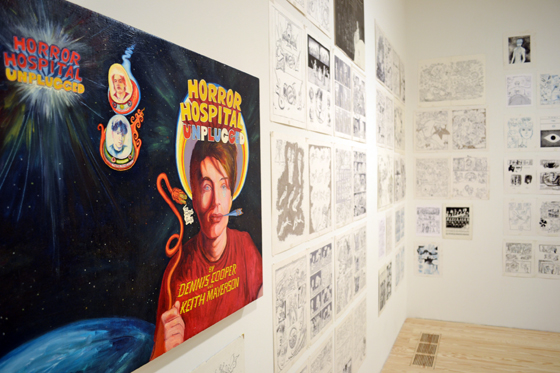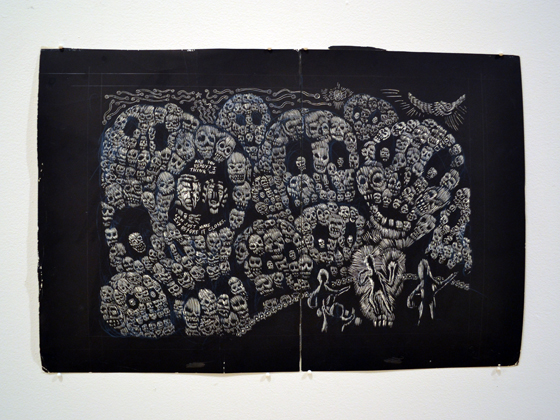- Artists: Keith Mayerson and Dennis Cooper
- Date: October 14th, 2011 – November 12th, 2011
- Venue: Derek Eller Gallery
- Address: 615 West 27th Street
- Venue Phone: 212-206-6411
- Website: www.derekeller.com
Why go to a gallery to see a graphic novel? In the case of Horror Hospital Unplugged at Derek Eller Gallery, we're given a larger picture than is offered by the book alone. As with any great graphic novel, artist Keith Mayerson and author Dennis Cooper understand the work as a visual and lyrical rhythm rather than a series of individual pages; the effect, when seen spread out in rows across three walls, is a transformation from linear narrative to a score of washes, scratches, and text.
The novel has been out of print since its original publishing in 1996, and was brought back this summer by Harper Perennial. It's easy to see why Horror Hospital remained underground for so long; as Mayerson joked in a recent article, it “is too arty for comics, too comics for art, and too gay for everyone.” The story follows sexually confused teen Trevor, lead singer for the indie rock band Horror Hospital, as he stumbles through sexual exploration toward fame.
One can glean a basic overview of the story simply by looking at the art: just as Charles Burns's lines describe certain scenes from Black Hole at a glance, the achievement here is in the pitch-perfect combination of narrative, pacing, and visual description. Pages revolve between tight, calligraphic renderings and large, furiously loose black brush strokes. Scratches and scrawling marks build up a rhythm that gushes from page to page, communicating youthful fantasy that plummets into utter despair. References to multiple comic styles often set the tone for each scene: tender moments are described through anime, concert scenes evoke 80s punk art, businessmen resemble 40s comic noir, and overall it looks a bit like the art of the Zap Comix generation.
The opening scene, rendered in panels of naive, dream-like shapes, shows Horror Hospital performing at a bar. Love scenes are similarly treated with the tender detail that one might find in a teenage girl's diary; a man who looks like a gay Clark Gable-Clark Kent lovechild, his chiseled features and wavy hair described in smooth, even lines, is surrounded by tiny, iconographic stars and rainbows. There are dicks everywhere, of varying size and shape; as the book progresses, and as scenes become more frightening, they are more often monstrous, tree-trunk fire hydrants that shoot rivers.
When things start to fall apart for Trevor, so do the marks and the traditional comic layout. Scenes that are more frightening often become quick, all-over full-size drawings and ink paintings. A hurriedly-brushed, full-page version of Munch's “The Scream” follows what appears to have been a violent orgy. In the last few rows of drawings, Horror Hospital returns to the bar, but this time it's full of skulls that are scratched out of black paper. The final pages are a series of morphing, crying, rudimentary cartoon faces, over which is spelled, in thick, black ink: “I WANT TO DIE.”
Just as Keith Mayerson's drawings are composed of layers of wet and dry ink, his paintings often walk a line between scumble and ooze. The drawings are flanked by two oil paintings, both of which have been used as cover art for respective editions of the novel; the painting on the end, on its own, is a kicker. Like most of Mayerson's painting, the surface is fervently worked over with small strokes; its pastel palette and level of finish read as a softer eulogy to the explosive ink drawings. A boy lies, arms splayed, as if playing dead. His T-shirt reads “I IS SOME ONE ELSE,” in reference to the morphing characters and styles used throughout. It looks to have been made eons after the first painting, which is, by comparison, a colorful, clunky cartoon portrait of a boy in space holding the male end of an electrical plug.
Mayerson has conjured something that only drawing can achieve: an emotional saga, through a deluge of marks. The gem is the drawings' rawness and spontaneity, perhaps made possible because they are meant for a private reading experience; they're beautiful, but aesthetic is completely and honestly secondary to content. I wondered, seeing them exposed in rows, if drawings-made-for-individual-viewership beget a more intimate relationship.
Approaching this through established avenues, one easily understands what Mayerson means by “too arty for comics” and “too comics for art”; try to read it as a story, and the narrative is inconsistent. Compare it to the polished text and collage drawings of Dominic McGill, which currently share the gallery space, and Mayerson's unframed, sketchy pages look sloppy. But this is what's great about the book: what person is consistent? And does professionalism really have anything to do with art? Experimental, process drawing rarely does much for graphic novelists, but it consistently wins accolades for a few fine artists, such as Kara Walker and William Kentridge. Maybe it's time to take a closer look at what's really breaking ground; Horror Hospital Unplugged exhibits a recklessly experimental quality that rarely surfaces, anywhere.
AFC’s Rating: 8/10 (Whitney Kimball)




Comments on this entry are closed.